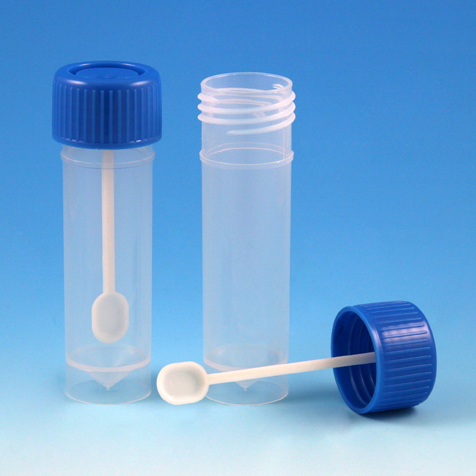Recent Salmonella recalls have led to some questions about the best way to diagnose salmonellosis in dogs and cats.
The first issue is when to test. In general, there is no indication to test healthy animals. Testing should be reserved for animals with diarrhea or other signs of salmonellosis (e.g. fever).
When testing is indicated, a few things should be considered:
- A fresh sample is best. It should be submitted for testing as soon as possible, but it can be kept cool (i.e. refrigeration temperature) for a day or more if it can’t be submitted right away. (Do NOT keep a fecal sample in your fridge at home! Take it to your local vet clinic and they will keep it in a designated specimen fridge.)
- More is better. A reasonable volume of stool (e.g. a tablespoon or two) is preferred to something like a rectal swab. Testing can be performed on rectal swabs but they are lower yield because they contain a lot less stool. See image right: standard-size 30 mL fecal sample containers (click for source).
The Test
There are two tests used to detect Salmonella in feces: culture and PCR.
Culture is used to grow and isolate the Salmonella bacterium. Usually, enrichment culture is used, whereby the sample is first cultured in a selective broth culture medium, then put on culture plates. This increases the recovery rate but takes more time.
Advantages of culture are:
- A positive is definitive – the bacterium is definitely there and alive.
- An isolate is available for subsequent testing such as determining the susceptibility to antibiotics and typing it to see what strain is involved.
Disadvantages of culture:
- Salmonella can be hard to grow for labs that don’t have a lot of experience and good protocols.
- A few days are required to obtain results, particularly if proper enrichment methods are used.
PCR (polymerase chain reaction) is a molecular diagnostic test that looks for DNA from a particular organism (in this case, Salmonella).
Advantages of PCR:
- Speed. Results may be available within 24 hours.
Disadvantages of PCR:
- Tests validated for dogs and cats are not usually available.
- The test detects both live and dead bacteria, so a positive result could theoretically be from ingestion of dead (and therefore irrelevant) bacteria.
- False negative results can occur from low levels of Salmonella or substances in the stool sample that inhibit the test.
- Lab quality control is critical but not always good.
Current recommendations are to base diagnosis on culture. PCR can be used as a faster presumptive test, but culture should be performed to confirm the diagnosis and get a bacterial isolate that can be further tested for antibiotic sensitivity and typed to see what strain is involved.
